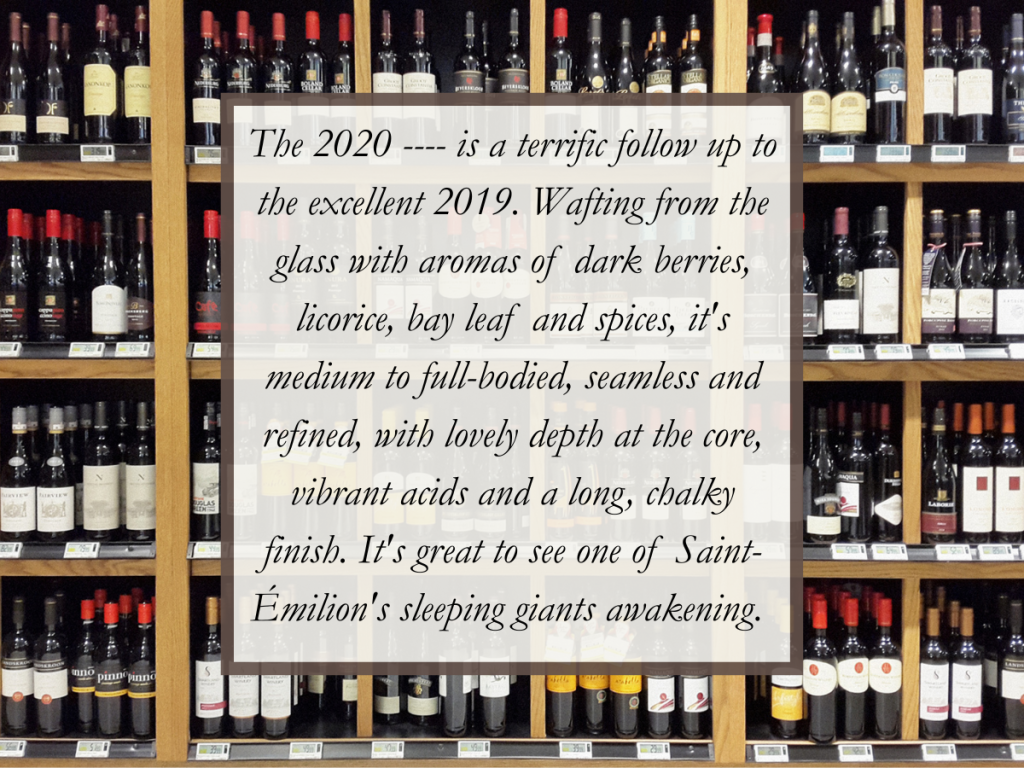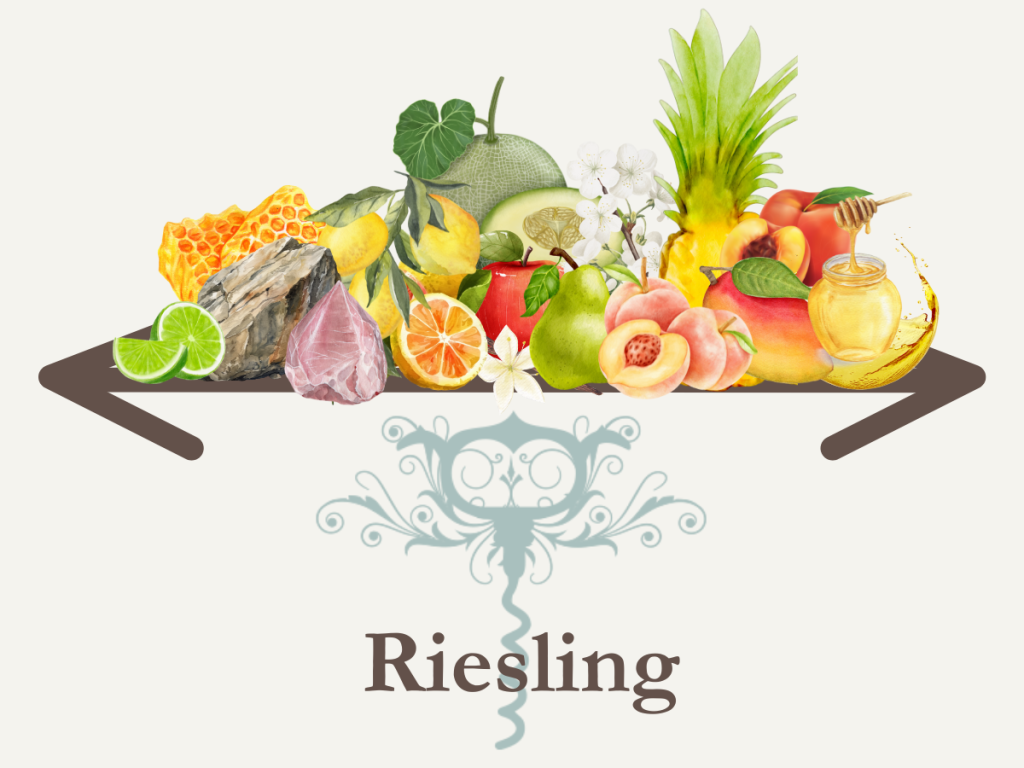I personally love reading wine write-ups that work to describe a bottle of wine… and then carefully rolling my eyes over the heavy use of adjectives that give the reader zero idea of what is in the bottle.
Like this:

If you are looking at the page or staring at the bottle or familiar with the Saint-Émilion region, you know this is a red Bordeaux wine. At best we get that the wine smells like “dark berries, licorice, bay leaf, and spices.” That’s a pretty straightforward description of young Bordeaux wine: berry and spice… likely smells like red wine. And now the fluff:
- “Medium to full-bodied,
- Seamless
- Refined
- Lovely depth at the core
- Vibrant acids
- Long, chalky finish.”
What does it all mean?!
At most, here’s how I – as someone trained in wine sensory – would pull a part this description:
- Medium to full-bodied à This is the viscosity of the wine, how thick it feels in the mouth. Let’s think about a drink that we all can probably relate to: milk. Skim milk is fat free, and it has a watery, thinner or light-bodied mouthfeel. 2% Milk is more medium-bodied. And whole milk or even half-and-half will end up in the full-bodied range. Therefore, they are saying, this wine falls somewhere between how thick 2% and whole milk feels in the mouth.
- Seamless à This is a doozy of a descriptor. I’m going to guess what the writer is saying is that there are no “holes” in the mouthfeel. The wine has a strong beginning, middle, and end so it doesn’t just pop in the beginning and pop at the end. Some wines, like Viognier, feel pretty weak at first sip and then the finish just pops in your mouth. That would be the opposite of “seamless.”
- Refined à I’m going to say that the tannic or phenolic structure, which contributes to mouthfeel and astringency, is not over-the-top. It’s likely the wine is drying (astringent), but not so much so that you cannot drink it upon purchase.
- Lovely depth at the core à I call this wine descriptor fluff. Meaningless in my opinion and does nothing but appeal to, perhaps, your appeal to the term “lovely.”
- Vibrant acids à The wine tastes more acidic than the American palate is used to in red wines.
- Long, chalky finish. à Maybe there is a flavor essence of chalk in the finish, but my guess is the wine is fairly astringent. This will make your mouth feel dry like you need water.
And at the end of this my expectation is: wine tastes like neutral red wine, is going to be acidic, dry, and relatively astringent.
I guess my summary doesn’t seem nearly as… enticing.
Or does it?
Because my guess is at least you know from my summarized expectation what you’re getting. Did you know to expect this from the description provided?
Wine Descriptions are for Wine Experts… Not Wine Lovers
My hang up with wine descriptions are that they appeal to a wine expert audience: people like me that don’t mind teasing away the fluff from someone who likes to write poetically about a wine. It puts way too much onus on you, Wine Lover, to know what they are talking about and to have faith in their description that you’ll enjoy what is in the bottle.
While I would love to change the way wine writers talk about wine, I know that is an uphill battle.
So let me give you some tools to help you better understand what you taste in order to get a firmer idea on reading fluffy wine descriptions!
Wine Tastes
Taste is the easiest thing to describe because it includes 5 characteristics:
- Sweetness: the taste of sugar. Sweetness exists in a range with “off-dry” or “semi-sweet” descriptors indicating a wine is less sweet than a “sweet” wine.
- Saltiness: the taste of salt.
- Bitterness: sharpness of taste, sometimes pungent. Bitterness is often off-putting for those that can detect it easily.
- Sourness: the taste of acid, like that of a lemon. Sour sensations make your mouth salivate. Wine writes will use terms like “vibrant,” “refreshing, and “crisp” to describe a more sour wine.
- Umami: a savory taste.
That’s it. Those 5 characteristics describe how something tastes, with each potential characteristic not being there, at a low intensity level, or at a high intensity level.
Only sweet, sour, and bitter relate to the taste of wine; salty and umami are not found in wines.
However, wine can also contain other taste sensations, which includes:
- Astringency: a drying, puckering, and somewhat numbing sensation. Many tannic or phenolic substances in wine will provide an astringency sensation.
- Fullness/Viscosity: thickness of a fluid. To some degree, light-bodied, medium-bodied, and full-bodied taste descriptors relate to the viscosity.
- Heat: a pain signal elicited by spice or heat of a substance, which is not detected through the taste buds. Alcohol can elicit the heat response.
Thus, when we talk about how a wine tastes, these are the primary descriptors.
Wine Flavor
Almost everything else that a wine writer describes pertains to flavor. The flavor is more descriptive and specific towards a wine. And, oddly enough, flavor is related to how a wine smells, which we often call the wine’s aroma. The general difference between aroma and flavor is where we perceive the essence.
A wine’s aroma is composed of hundreds of different chemicals, referred to as aroma compounds. Each aroma compound is a small molecule, which is volatile or gaseous. These are super small molecules that can escape the liquid (wine) into the surrounding air as a gas. When those molecules exist in their gaseous form, we sense them through our external organ, the nose.
The aroma compounds go into the nose and into the nasal cavity, which contains various receptors that interact with the aroma compounds. When those aroma compounds interact with the receptors, a signal is sent to the brain and the brain tells what that smell is.
For example, let’s pretend you are slicing an orange. As you slice the orange, some of those aroma compounds get into the surrounding air. Quite quickly after your first slice, you will begin to smell the orange and recognize the orange smell.
This phenomenon happens with anything that you smell. But because wine is a complex beverage, composed of hundreds of aroma compounds, we can often smell various things in the wine. These light aromas that we detect actually make up the wine’s varietal character, which is a spectrum of various aromas that are unique to that wine grape variety. These spectrums are essentially fingerprints – or, “smellprints,” if you will – of a wine grape variety. For example, Chardonnay’s “Smellprint” looks something like this:

Image Created by Denise M. Gardner
In contrast, Riesling’s “Smellprint” looks something like this:

Image created by: Denise M. Gardner
It is these aromas that wine experts study extensively to start to allow them to identify various wine varieties or wine regions from which various grapes are grown.
In comparison, flavor derives from the same aroma compounds that make up the wine’s smell. The difference is where we sense the aroma compounds. Instead of smelling the aroma compounds through our noses, when we put a sip of wine in our mouths, some of the aroma compounds escape the liquid and transfer up through a passageway in our throat to our nasal cavity. There, the aroma compounds interact with the nasal cavity receptor sites, and send a corresponding signal to the brain that registers to us as a flavor.
This is why things we don’t typically put in our mouths – like a wet dog or a barnyard – can exist as aroma/flavor descriptors for a wine. The compounds are gaseous and we can either perceive that compound through our nose or in our mouth while tasting the wine.
What Does This Mean for Understanding What a Wine Tastes Like?
In addition to those basic tastes, most of what you read about a wine will be related to the flavor.
If we use those descriptors we saw above:
“dark berries, licorice, bay leaf, and spices.”
This is an attempt to describe the wine’s flavor. Because there are only a handful of descriptors, and most of them are relatively generic, we can assume the wine tastes fairly neutral, or will likely come across as “tasting like red wine.”
Let’s look at another wine description:
“Made by —– and already bottled, the 2023 —– comes from the Mission Mills Vineyard just outside of Los Alamos. Its vivid medium gold hue is followed by a vibrant nose of salted citrus, tangerine, exotic flowers, and subtle spice. Medium-bodied, pure, rounded, and beautifully balanced, it has plenty of power and density, integrated acidity, and a great finish. This impeccably made —– should be snatched up by readers, as it competes with wines at two to three times the price.”
Can you spot the aromas or flavors?
It’s always going to be the more descriptive terms.
In this case, that would include: “salted citrus, tangerine, exotic flowers, and subtle spice.” I will note that “salt” or “salty” or “salted” is sometimes used as a aroma/flavor descriptor with wine. While we cannot smell salt, we can smell the volatile components that often make up salt’s impurities, and I’d say that aroma/flavor reminds me of what it smells like when you get off of a plane in a tropical, beach area.
In general, white wines will feature citrus fruits, stone fruits, and tropical fruits as their primary flavors. Red wines feature red or black berries. Finally, rosé wines will either lean towards a citrus flavor or a light strawberry flavor. We talked a bit more extensively about rosé wine flavor in “Everything’s Coming Up Rosé.” Any of these styles can have a floral aroma/flavor as well.
You Can Guess Wine Flavors and Tastes
The primary secret to reading these wine descriptions is first, pulling out the “fluff,” the extra writing that doesn’t describe how the wine tastes or smells.
The second part of the secret is then dividing tastes from aromas/flavors. All of the primary options for tastes are listed above. When it comes to “knowing” all of the various aromas and flavors, that lexicon can get lengthy. Wine Aroma Wheels are helpful by providing a list of descriptive terms for aroma and flavor. Many of these feature the most common descriptors associated with nuanced aromas and flavors in wine.
Give it a try. See if you can buy your next wine off of a description… and then see if it matches what someone else said. I would love to know how this works out! If you try it, DM or tag me on Instagram @dgwinemaking.

